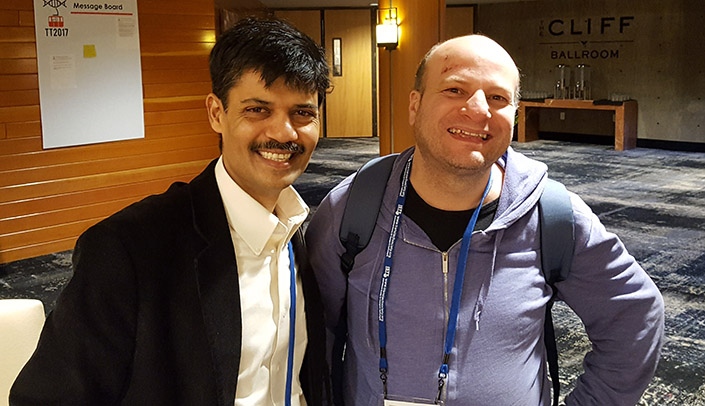A global collaboration — led by two researchers 9,000 miles apart — has evaluated several CRISPR-Cas9 gene editing methods used for routine generation of specific animal models.
Channabasavaiah Gurumurthy, Ph.D., of UNMC, and Gaetan Burgio, Ph.D., of Australian National University are corresponding authors on the paper recently published in Genome Biology, which includes 112 other authors from 20 labs around the world.
“Genetic engineering is complex,” Dr. Gurumurthy said. “Our paper analyzed all available methods to determine which offer higher efficiencies in generating complex animal models called conditional knockouts, which ultimately provide greater insight into gene function and disease findings.
“The results are important because custom-engineered conditional knockout animal models are widely used in biomedical research from basic studies to drug development.”
Dr. Gurumurthy is director of the Mouse Genome Engineering Core at UNMC and associate professor of pharmacology and experimental neuroscience. His previous research contributions include a breakthrough in genome engineering termed Easi-CRISPR (Efficient additions with ssDNA inserts-CRISPR). Easi-CRISPR is one of the most efficient technologies that allows scientists to custom-engineer important animal research models much more rapidly and at a significantly lower cost.
In their recent paper, titled “Reproducibility of CRISPR-Cas9 methods for generation of conditional mouse alleles: a multi-center evaluation,” the global team analyzed the first CRISPR method published six years ago in Cell and compared it with the newer methods including Easi-CRISPR. Their findings? The Cell paper approach was less than 1% efficient, based on their data from over 50 genes analyzed from 20 laboratories, whereas the Cell study had reported 16% efficiency based on data using just one gene. Easi-CRISPR and the related methods were 10 to 20 times more efficient than the Cell paper approach.
“These results demonstrate the gene editing field has considerably evolved from the past five years to make CRISPR more safe and efficient,” Dr. Burgio said.
Dr. Burgio’s group analyzed the extensive biological data including a process called machine learning, which provides systems the ability to automatically learn and improve from experience without being explicitly programmed.
“Dr. Gurumurthy has nearly singlehandedly developed this technology at UNMC with the support of one of our Centers of Biomedical Research Excellence grants,” said Jennifer Larsen, M.D., vice chancellor for research. “This article demonstrated how he continues to bring innovations not only to UNMC but the broader research community. We are proud of his many accomplishments.”
“The progress in Dr. Gurumurthy’s research is matched by his innovation and dogged determination,” said Howard Gendelman, M.D., Margaret R. Larson Professor of Infectious Diseases and Internal Medicine, chair of the UNMC Department of Pharmacology and Experimental Neuroscience and director of the Center for Neurodegenerative Diseases. “We are proud to call him one of our own.”

Congrats to Guru and his team. You are a great asset to UNMC!
Tremendous work by Team Guru!! You are helping UNMC lead the world. Congrats!
Congratulations Guru! It's wonderful to see you being recognized for your important contributions and continued refinements and improvements to science. Also appreciate the shout-out to Dr. Smith's CoBRE which has helped so many scientists and contributed support to UNMC's excellent core research facilities. Your determination is impressive. Very Best to you.
Outstanding work – congratulations!!
Congratulations Guru! Wish you the very best for many more successes to come.
Congratulations Guru and the team, great recognition!!